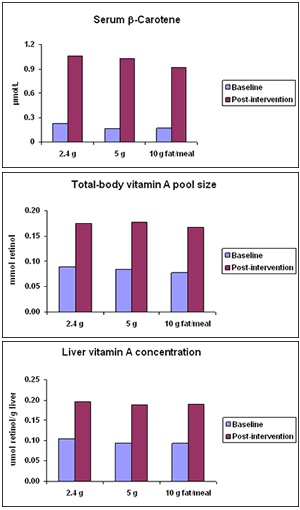Judy D. Ribaya-Mercado, Sc.D.
Jean Mayer USDA Human Nutrition Research Center at Tufts University, 711 Washington St., Boston, Massachusetts 02111, USA
Background
 Vitamin A deficiency is a serious public health problem affecting millions of people in Southeast Asia and Africa. Severe tragic consequences may include growth retardation, anemia, reduced resistance to infection, impaired cellular differentiation, and ultimately, blindness, and death. In the Philippines, the 1998 National Nutrition Survey (1) showed that 38.0% of children between the ages of 6 months and 5 years, 22.2% of pregnant women, and 16.5% of lactating women have deficient to low plasma vitamin A (retinol) concentrations. School-aged children are also vulnerable to vitamin A deficiency because the periodic high-dose vitamin A supplements provided by WHO, UNICEF and other agencies to developing nations is targeted only for children up to 5 years of age. The elderly are likewise vulnerable to vitamin A deficiency. A study conducted among Filipino elders residing in rural communities found a 15% prevalence of low liver vitamin A as assessed by stable-isotope-dilution methodology (2).
Vitamin A deficiency is a serious public health problem affecting millions of people in Southeast Asia and Africa. Severe tragic consequences may include growth retardation, anemia, reduced resistance to infection, impaired cellular differentiation, and ultimately, blindness, and death. In the Philippines, the 1998 National Nutrition Survey (1) showed that 38.0% of children between the ages of 6 months and 5 years, 22.2% of pregnant women, and 16.5% of lactating women have deficient to low plasma vitamin A (retinol) concentrations. School-aged children are also vulnerable to vitamin A deficiency because the periodic high-dose vitamin A supplements provided by WHO, UNICEF and other agencies to developing nations is targeted only for children up to 5 years of age. The elderly are likewise vulnerable to vitamin A deficiency. A study conducted among Filipino elders residing in rural communities found a 15% prevalence of low liver vitamin A as assessed by stable-isotope-dilution methodology (2).
Vitamin A is a fat-soluble essential nutrient that is obtained from plant foods in the form of provitamin A carotenoids (beta-carotene, alpha-carotene, beta-cryptoxanthin) or from animal products (e.g., liver, dairy products) in the form of preformed vitamin A. Plant foods are often the primary sources of vitamin A in some populations in whom vitamin A deficiency is prevalent, thus, strategies for improving the absorption and bioconversion of plant carotenoids are essential.
It is well-known that dietary fat enhances carotene uptake from foods; however, the amount of fat needed for optimal carotenoid utilization is not clear. In some studies, but not in others, the ingestion of plant carotenoids with dietary fat enhanced serum (or plasma) retinol. The circulating retinol, however, is not a good measure for evaluating the effectiveness of nutritional interventions because it is subject to control mechanisms. Depending on the amount of vitamin A stores in liver, serum retinol could remain unchanged during dietary interventions. Over the past decade, stable-isotope-dilution methods have emerged as the state-of-the-art procedures for biochemical assessment of vitamin A status. Stable isotopes are used as tracers in metabolic studies and are safe to ingest. Deuterated-retinol-dilution (DRD) techniques employ deuterium-labeled vitamin A, and provide a numerical estimate of the total-body vitamin A pool size and of liver vitamin A concentration (3).
 |
| Figure 1. Mean serum β-carotene concentrations, total-body vitamin A pool sizes, and liver vitamin A concentrations in Filipino schoolchildren at baseline and after ingesting standardized carotene-rich vegetable meals with 2.4, 5, or 10 grams fat per meal 3 times daily, for 5 days a week, for 9 weeks. |
In a recent study in marginally-nourished Filipino schoolchildren, Ribaya-Mercado and her colleagues (4) investigated the influence of amounts of dietary fat on a) the bioavailability of provitamin A carotenoids from yellow and green leafy vegetables by measuring changes in serum carotenoid concentrations, and b) the effectiveness of plant carotenoids in improving vitamin A status by using the DRD technique.
Subjects and Methods
Subjects
The study participants were 116 children who were 9-12 years old and enrolled in the elementary schools of Banawang and Overland in Bagac, Bataan. The study sites were chosen because of high prevalences of subclinical vitamin A deficiency based on the 1998 National Nutrition Survey (1).
Dietary Intervention
The children were fed standardized meals 3 times daily, for 5 days a week, for 9 weeks in their schools. The meals consisted of traditionally-accepted recipes, and provided 4.2 milligrams of provitamin A carotenoids (mainly beta-carotene) from yellow and green leafy vegetables, i.e., carrots, pechay, squash, and kangkong, and different amounts of dietary fat (2.4, 5, or 10 grams fat per meal). Vegetables and other ingredients in the menu were boiled separately, and predetermined amounts were weighed and placed in individual food containers for each child. Refined coconut oil, the most common source of dietary fat in rural Philippine communities, was added by using custom-made ladles of different sizes that delivered the desired amounts. In the groups fed more fat, carbohydrate was reduced to provide similar amounts of energy. There were no dietary restrictions imposed on the study participants. However, they or their caregivers were asked to daily record all self-selected foods eaten that were not provided in the study meals. Dieticians from the Nutrition Center of the Philippines were responsible for all of the dietary aspects of the study, including the purchase, preparation and cooking of foods, and the weighing of meal components into color-coded food containers. They supervised the study participants during meals at school and recorded their food intakes and any plate waste; they verified and kept daily records of all self-selected foods eaten during the 45 school days and 16 weekend days of the study period.
Biochemical Assessments
At baseline and after 9 weeks of food intervention, serum carotenoid and retinol concentrations were measured by using HPLC; and total-body and liver vitamin A stores, by using the DRD technique. In DRD, a known amount of deuterated vitamin A is ingested and allowed to equilibrate (or mix) with the body’s vitamin A pool; equilibration takes about 20 days to complete (3). The method is based on the principle that when an individual’s vitamin A status is poor, less dilution of an oral dose of incoming labeled vitamin A by the body’s vitamin A pool size occurs, resulting in a relatively higher ratio of labeled- to non-labeled retinol in serum. The isotopic ratio is used in a mathematical equation (Olson equation) to obtain a numerical estimate of the total-body vitamin A pool size and of liver vitamin A concentration (3).
Results
The total daily beta-carotene intake (from study meals plus self-selected foods) during the 9-week intervention period was 14 times the usual intake; total fat intake was either similar to, or 1 ½ or 2 times more than the usual intake. In the groups fed the 3 different amounts of fat, similar increases in serum beta-carotene (5-fold), alpha-carotene (19-fold), and beta-cryptoxanthin (2-fold); total-body vitamin A pool size (2-fold), and liver vitamin A concentration (2-fold) were observed. Serum retinol did not change in any of the groups. After 9 weeks, the overall prevalence of low liver vitamin A decreased from 35% to 7%.
Conclusions and Significance of the Findings
Only a small amount of fat is needed for optimal utilization of plant provitamin A carotenoids. The poor or marginal vitamin A status observed in the study participants at baseline cannot be attributed to insufficient fat intakes, but rather to insufficient intakes of food sources of vitamin A. The stable-isotope-dilution methodology is a powerful tool for assessing vitamin A status and evaluating the effectiveness of interventions aimed at improving the vitamin A status of populations. On the basis of data obtained with the use of other vitamin A assessment methods (e.g., serum retinol measurements, etc.) the effectiveness of plant carotenoids in combating vitamin A deficiency has been questioned (5). Data from the present study indicate that carotene-rich plant foods, when ingested with minimal fat, can effectively meet vitamin A needs and restore low liver vitamin A concentrations to normal levels. This finding is of public health importance especially in developing nations where health professionals and policymakers can promote the use of carotene-rich vegetables for combating vitamin A deficiency in vulnerable groups.
References:
- Food and Nutrition Research Institute (FNRI), Department of Science and Technology (DOST). Philippine Nutrition Facts. Taguig, Metro Manila:FNRI-DOST, 2001.
- Ribaya-Mercado JD, Solon FS, Fermin LS, Perfecto CS, Solon JAA, Dolnikowski GG, Russell RM. Dietary vitamin A intakes of Filipino elders with adequate or low liver vitamin A concentrations as assessed by the deuterated-retinol-dilution method: implications for dietary requirements. Am J Clin Nutr 79:633-641, 2004.
- Haskell MJ, Ribaya-Mercado JD, Vitamin A Tracer Task Force. Handbook on Vitamin A Tracer Dilution Methods to Assess Status and Evaluate Intervention Programs. HarvestPlus Technical Monograph Series 5. Washington, DC: International Food Policy Research Institute, 2005.
- Ribaya-Mercado JD, Maramag CC, Tengco LW, Dolnikowski GG, Blumberg JB, Solon FS. Carotene-rich plant foods ingested with minimal dietary fat enhance the total-body vitamin A pool size in Filipino schoolchildren as assessed by stable-isotope-dilution methodology. Am J Clin Nutr 85:1041-1049, 2007.
- de Pee S, West CE, Muhilal, Karyadi D, Hautvast JGAJ. Lack of improvement in vitamin A status with increased consumption of dark-green leafy vegetables. Lancet 346:75-81, 1995.
__________
Dr. Judy Ribaya-Mercado is a graduate of the University of Santo Tomas (BS Chemistry), the Ohio State University (MS Physiological Chemistry), and the Harvard University School of Public Health (ScD Nutrition). Currently, she is a Scientist at the Jean Mayer USDA Human Nutrition Research Center at Tufts University, Boston, Massachusetts, USA. She can be reached by email at judy.ribaya-mercado[@]tufts.edu.